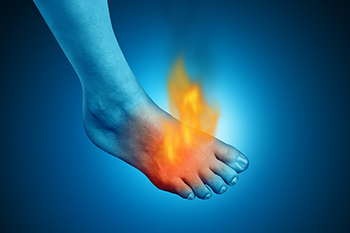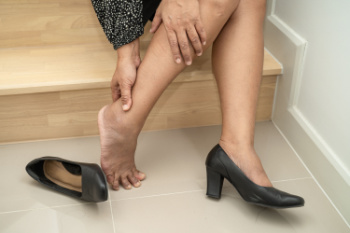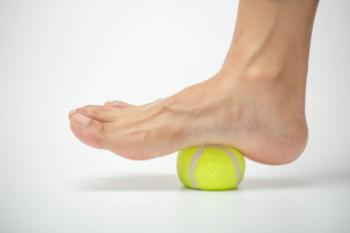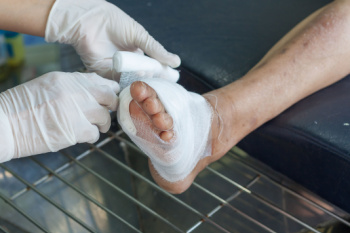Items filtered by date: July 2024
Causes of Burning Feet While Running

Experiencing a burning sensation in your feet while running can be painful and disrupt your fitness routine. This common issue can arise from overuse of foot muscles, iwearing mproper footwear, and friction. Running on hot surfaces and excessive sweating are other factors for burning feet. Overworking your foot muscles without adequate rest can lead to fatigue and a burning sensation. Friction from poorly fitting shoes or socks can irritate the skin while running on hot surfaces can directly cause a burning feeling. Excessive sweating creates a moist environment that can irritate the skin further. Addressing these issues through wearing proper footwear, moisture-wicking socks, and adequate rest can help alleviate symptoms. However, if the burning persists, it might indicate a more serious underlying condition such as nerve damage, diabetes, or hypothyroidism. If your feet feel like your feet are burning during a run, it is suggested that you schedule an appointment with a podiatrist.
Exercising your feet regularly with the proper foot wear is a great way to prevent injuries. If you have any concerns about your feet, contact Peter Siroka, DPM of Connecticut. Our doctor will treat your foot and ankle needs.
How to Prevent Running Injuries
Many common running injuries are caused by overuse and overtraining. When the back of the kneecap starts wearing out and starts causing pain in your knee, this is commonly referred to as runner’s knee. Runner’s knee is a decrease in strength in your quadriceps and can occur if you’re not wearing properly fitted or supporting shoes. To prevent runner’s knee, focusing on hip strengthening is a good idea, as well as strengthening your quads to keep the kneecaps aligned.
What Are Some Causes of Running Injuries?
- One cause of a common running injury is called iliotibial band syndrome.
- Plantar fasciitis is also another common injury.
- Stress fractures can occur from overtraining, lack of calcium, or even your running style.
Best Ways to Prevent Running Injuries
- Wear footwear that fits properly and suits your running needs.
- Running shoes are the only protective gear that runners have to safeguard them from injury.
- Make a training schedule. Adding strengthening exercises as well as regular stretching can help keep you strong and limber and can lessen the possibility of injuries.
- Stretching keeps muscles limber; this will help you gain better flexibility.
If you have any questions please feel free to contact our office located in Stamford, CT . We offer the newest diagnostic and treatment technologies for all your foot and ankle needs.
Why Foot Pain Should Not Be Ignored

Ignoring foot pain can lead to serious health issues, as it may indicate underlying conditions including psoriatic arthritis, diabetes, gout, or blood clots. Psoriatic arthritis causes joint pain and swelling, leading to permanent damage if untreated. In diabetes, foot pain might signal neuropathy or the onset of ulcers, necessitating immediate attention to prevent severe complications. Gout manifests as sudden, intense pain due to uric acid crystal buildup, requiring management to avoid chronic joint damage. Blood clots in the legs can cause pain and swelling, posing a risk of life-threatening complications if they travel to the lungs. Addressing foot pain promptly ensures proper diagnosis and effective treatment, preventing minor issues from escalating into serious conditions. If you have foot pain, it is strongly suggested that you schedule an appointment with a podiatrist who can offer effective treatment options.
Foot Pain
Foot pain can be extremely painful and debilitating. If you have a foot pain, consult with Peter Siroka, DPM from Connecticut. Our doctor will assess your condition and provide you with quality foot and ankle treatment.
Causes
Foot pain is a very broad condition that could be caused by one or more ailments. The most common include:
- Bunions
- Hammertoes
- Plantar Fasciitis
- Bone Spurs
- Corns
- Tarsal Tunnel Syndrome
- Ingrown Toenails
- Arthritis (such as Gout, Rheumatoid, and Osteoarthritis)
- Flat Feet
- Injury (from stress fractures, broken toe, foot, ankle, Achilles tendon ruptures, and sprains)
- And more
Diagnosis
To figure out the cause of foot pain, podiatrists utilize several different methods. This can range from simple visual inspections and sensation tests to X-rays and MRI scans. Prior medical history, family medical history, and any recent physical traumatic events will all be taken into consideration for a proper diagnosis.
Treatment
Treatment depends upon the cause of the foot pain. Whether it is resting, staying off the foot, or having surgery; podiatrists have a number of treatment options available for foot pain.
If you have any questions, please feel free to contact our office located in Stamford, CT . We offer the newest diagnostic and treatment technologies for all your foot care needs.
Plantar Warts Can Be Treated!
Benefits of Foot Exercises

Exercising your feet offers numerous benefits that can enhance your overall foot health, reduce pain, and keep you active. Gentle stretches and strength exercises improve flexibility and strengthen the muscles that support your feet, which can help prevent injuries and alleviate discomfort. For example, toe raise, point, and curl exercises can get your toes and feet moving, while toe splay movements help gain control over your toe muscles. Toe extensions are particularly beneficial for preventing or treating plantar fasciitis. Additionally, activities like toe curls, marble pickups, and big toe stretches strengthen various muscles in your feet and improve their range of motion. Rolling a tennis ball under your foot can also provide relief from arch pain and plantar fasciitis. Finally, Achilles tendon stretches help maintain flexibility while preventing foot, ankle, and leg pain. You can perform these foot exercises three days a week or even daily for lifelong foot health. If you have any injuries, arthritis, diabetes, or persistent foot and ankle pain, consult a foot doctor before starting any new exercise routine. It is suggested that you schedule an appointment with a podiatrist for an exam and expert treatment.
Exercising your feet regularly with the proper foot wear is a great way to prevent injuries and build strength. If you have any concerns about your feet, contact Peter Siroka, DPM from Connecticut. Our doctor can provide the care you need to keep you pain-free and on your feet.
Exercise for Your Feet
Exercise for your feet can help you gain strength, mobility and flexibility in your feet. They say that strengthening your feet can be just as rewarding as strengthening another part of the body. Your feet are very important, and we often forget about them in our daily tasks. But it is because of our feet that are we able to get going and do what we need to. For those of us fortunate enough to not have any foot problems, it is an important gesture to take care of them to ensure good health in the long run.
Some foot health exercises can include ankle pumps, tip-toeing, toe rises, lifting off the floor doing reps and sets, and flexing the toes. It is best to speak with Our doctor to determine an appropriate regimen for your needs. Everyone’s needs and bodies are different, and the activities required to maintain strength in the feet vary from individual to individual.
Once you get into a routine of doing regular exercise, you may notice a difference in your feet and how strong they may become.
If you have any questions please feel free to contact our office located in Stamford, CT . We offer the newest diagnostic and treatment technologies for all your foot and ankle needs.
Understanding and Caring for Diabetic Foot Wounds
 Diabetic foot wounds are common complications resulting from a combination of poor circulation and neuropathy, which reduces sensation in the feet. Risk factors can include prolonged high blood sugar levels, which damage blood vessels and nerves, and wearing ill-fitting shoes, which can cause blisters and sores. People with diabetes are more prone to infections due to a weakened immune response. Proper foot care is essential to prevent these wounds. Daily inspections for cuts, blisters, or any changes in skin color are vital. Keeping feet clean and dry, moisturizing to prevent cracking, and wearing comfortable, protective shoes are essential steps. Regular visits to a podiatrist for foot examinations and managing blood sugar levels effectively can also reduce the risk of severe complications. If you have diabetes, it is strongly suggested that you are under the care of a podiatrist who can help you to manage this condition.
Diabetic foot wounds are common complications resulting from a combination of poor circulation and neuropathy, which reduces sensation in the feet. Risk factors can include prolonged high blood sugar levels, which damage blood vessels and nerves, and wearing ill-fitting shoes, which can cause blisters and sores. People with diabetes are more prone to infections due to a weakened immune response. Proper foot care is essential to prevent these wounds. Daily inspections for cuts, blisters, or any changes in skin color are vital. Keeping feet clean and dry, moisturizing to prevent cracking, and wearing comfortable, protective shoes are essential steps. Regular visits to a podiatrist for foot examinations and managing blood sugar levels effectively can also reduce the risk of severe complications. If you have diabetes, it is strongly suggested that you are under the care of a podiatrist who can help you to manage this condition.
Diabetic foot care is important in preventing foot ailments such as ulcers. If you are suffering from diabetes or have any other concerns about your feet, contact Peter Siroka, DPM from Connecticut. Our doctor can provide the care you need to keep you pain-free and on your feet.
Diabetic Foot Care
Diabetes affects millions of people every year. The condition can damage blood vessels in many parts of the body, especially the feet. Because of this, taking care of your feet is essential if you have diabetes, and having a podiatrist help monitor your foot health is highly recommended.
The Importance of Caring for Your Feet
- Routinely inspect your feet for bruises or sores.
- Wear socks that fit your feet comfortably.
- Wear comfortable shoes that provide adequate support.
Patients with diabetes should have their doctor monitor their blood levels, as blood sugar levels play such a huge role in diabetic care. Monitoring these levels on a regular basis is highly advised.
It is always best to inform your healthcare professional of any concerns you may have regarding your feet, especially for diabetic patients. Early treatment and routine foot examinations are keys to maintaining proper health, especially because severe complications can arise if proper treatment is not applied.
If you have any questions please feel free to contact our office located in Stamford, CT . We offer the newest diagnostic and treatment technologies for all your foot and ankle needs.
Recovering from Ankle Surgery

Recovering from ankle surgery involves a careful balance of rest and rehabilitation to restore function and strength. An essential aspect of recovery is maintaining and improving ankle mobility. Early, gentle movements help reduce stiffness and promote circulation, aiding in the healing process. Ankle exercises play a vital role in regaining strength and flexibility. Simple exercises such as ankle circles, toe stretches, and resistance band exercises can enhance range of motion and prevent muscle atrophy. Following a podiatrist’s guidance ensures that exercises are performed correctly and safely. Consistent practice of these exercises helps in rebuilding the stability and strength of the ankle, enabling a smoother transition back to normal activities. If you have had surgery to relieve chronic ankle pain, it is suggested that a podiatrist is on your healthcare team who can guide you toward a safe and effective recovery.
Foot surgery is sometimes necessary to treat a foot ailment. To learn more, contact Peter Siroka, DPM of Connecticut. Our doctor will assist you with all of your foot and ankle needs.
When Is Surgery Necessary?
Foot and ankle surgery is generally reserved for cases in which less invasive, conservative procedures have failed to alleviate the problem. Some of the cases in which surgery may be necessary include:
- Removing foot deformities like bunions and bone spurs
- Severe arthritis that has caused bone issues
- Cosmetic reconstruction
What Types of Surgery Are There?
The type of surgery you receive will depend on the nature of the problem you have. Some of the possible surgeries include:
- Bunionectomy for painful bunions
- Surgical fusion for realignment of bones
- Neuropathy decompression surgery to treat nerve damage
Benefits of Surgery
Although surgery is usually a last resort, it can provide more complete pain relief compared to non-surgical methods and may allow you to finally resume full activity.
Surgical techniques have also become increasingly sophisticated. Techniques like endoscopic surgery allow for smaller incisions and faster recovery times.
If you have any questions please feel free to contact our office located in Stamford, CT . We offer the newest diagnostic and treatment technologies for all your foot and ankle needs.

